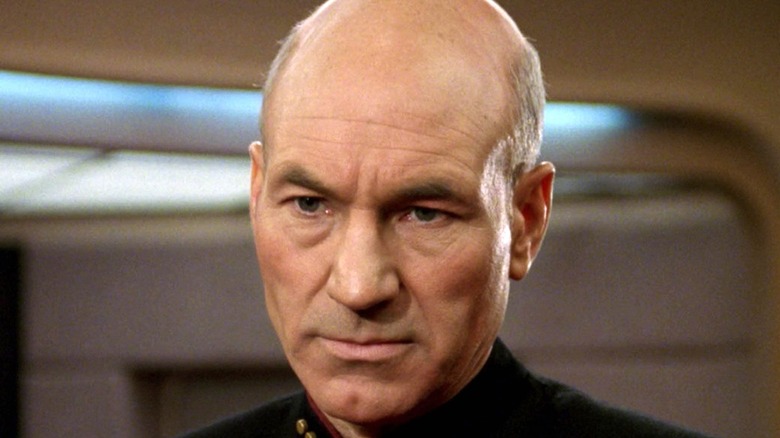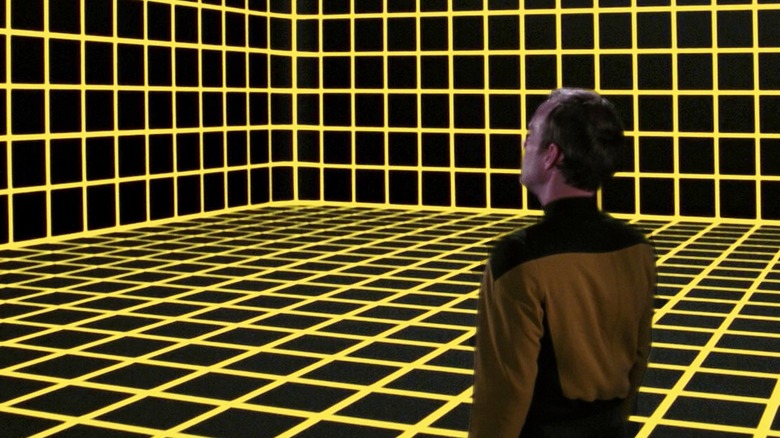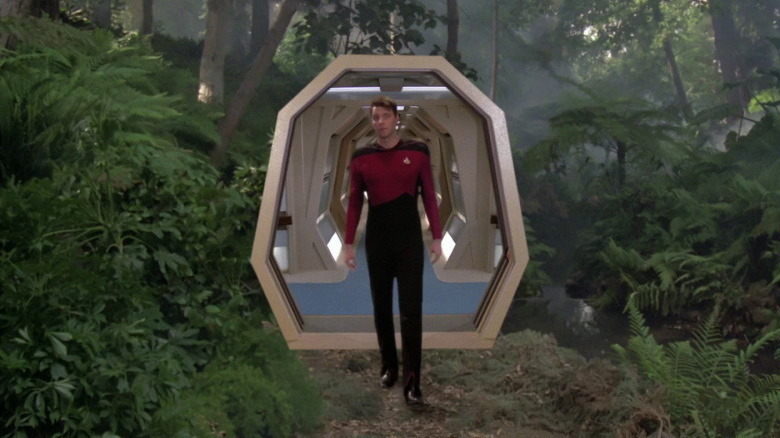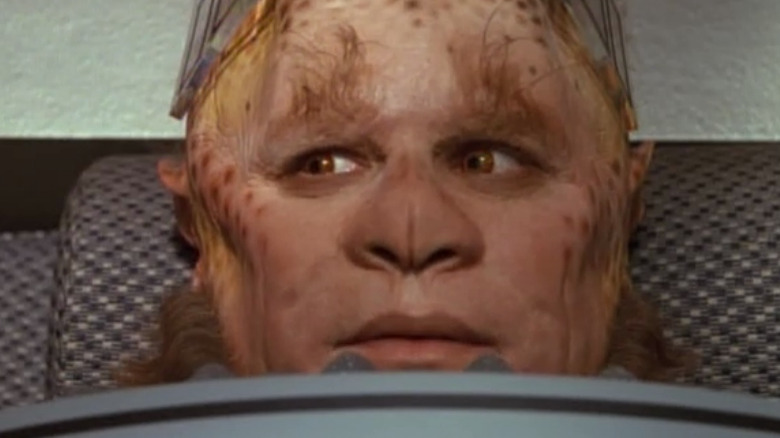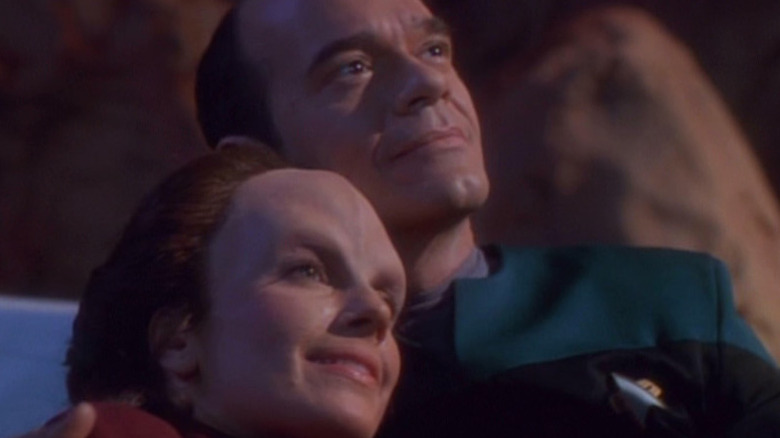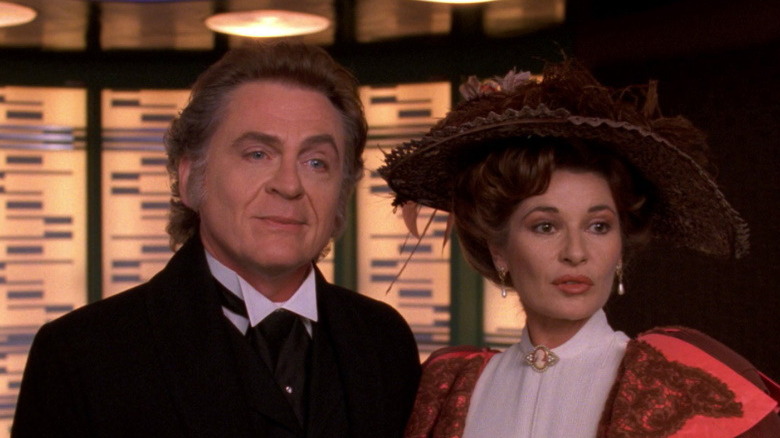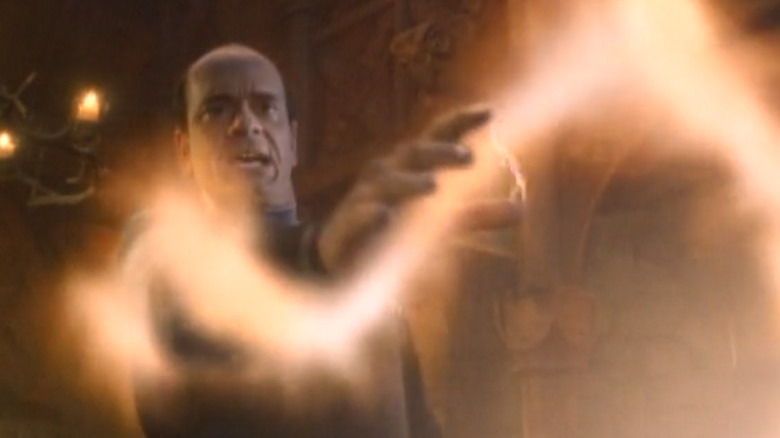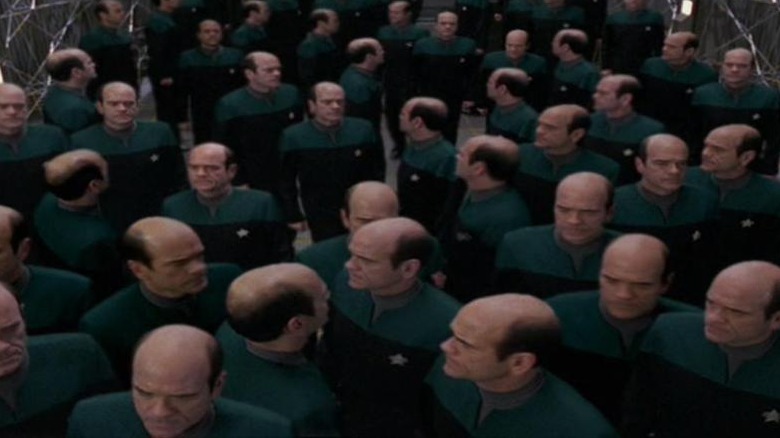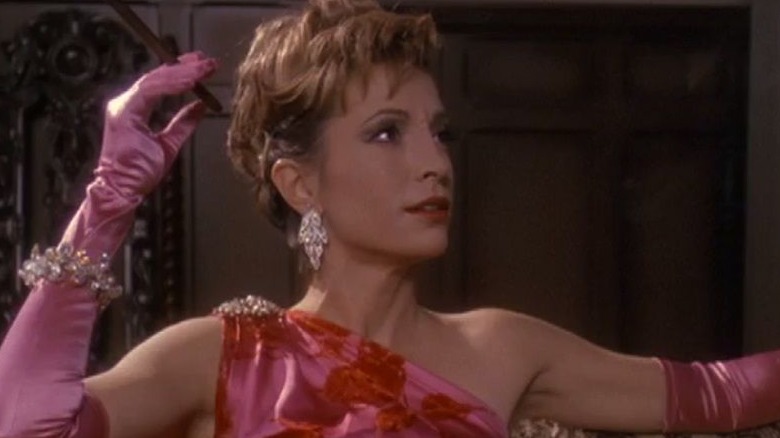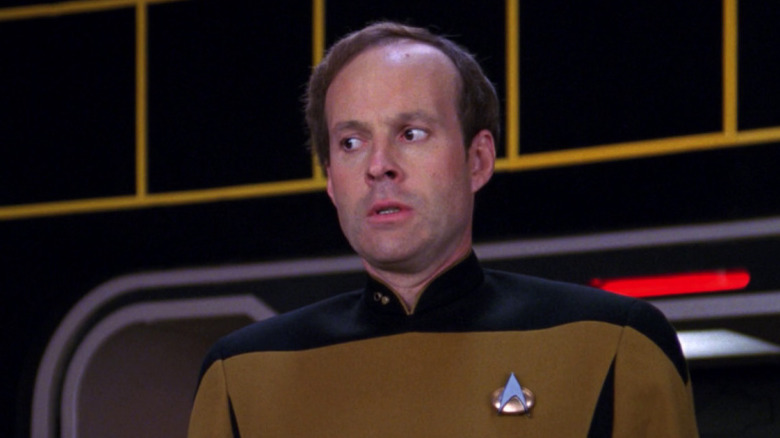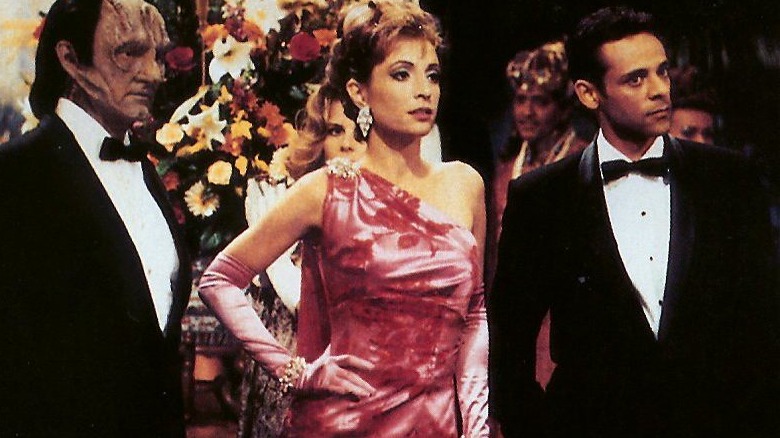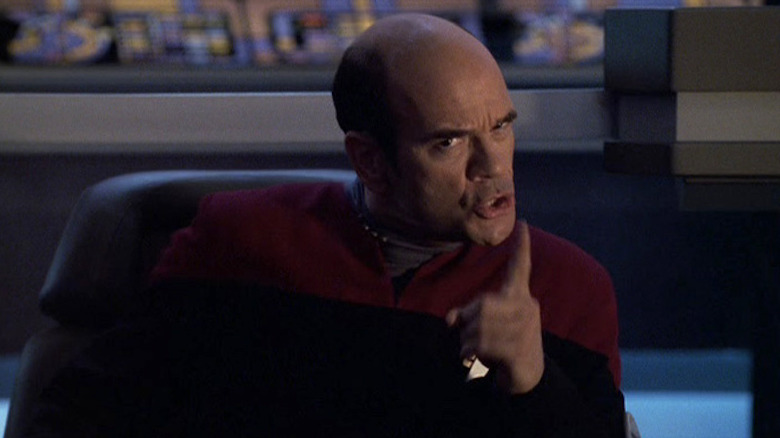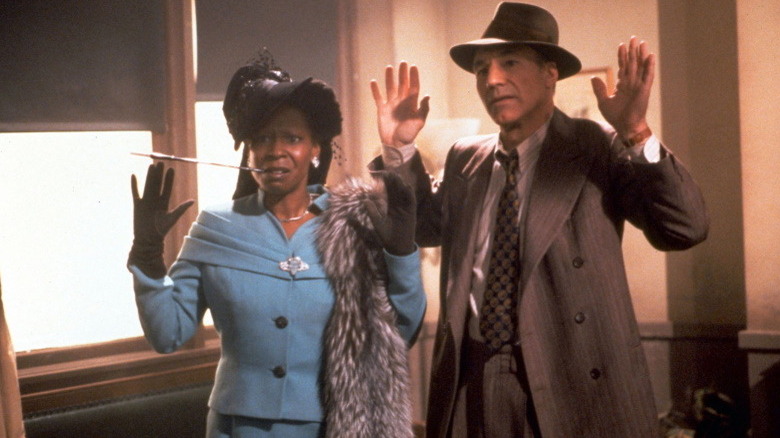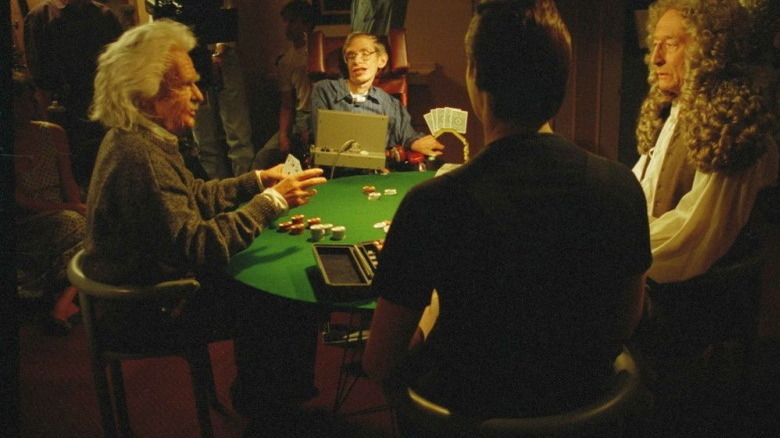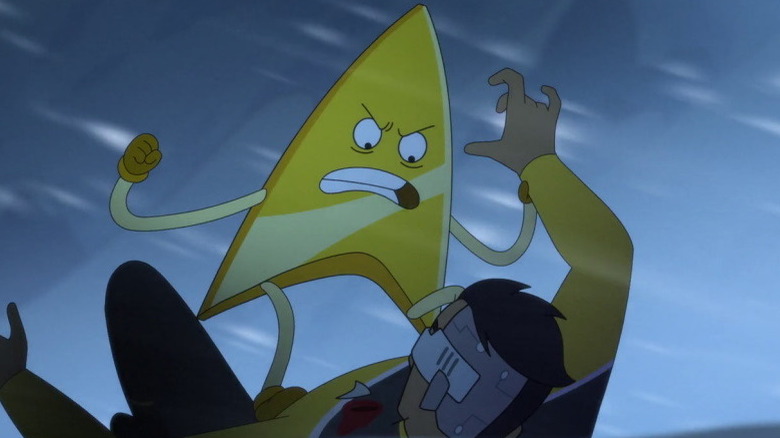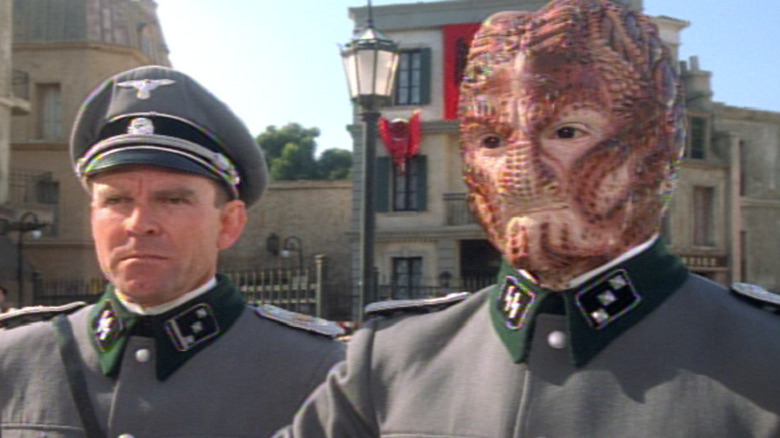The Untold Truth Of Star Trek Holograms
Ask anyone what piece of "Star Trek" technology they'd like to own, and odds are most people will want a personal holodeck. First introduced in "Star Trek: The Next Generation," the holodeck immerses you in an artificial reality full of holograms designed to look, sound, feel, smell, and even taste like anything — or anyone — you can imagine.
Just consider the possibilities. Sure, warp drive and transporters can take you to strange new worlds, but given how dangerous a lot of those alien planets can be, most people would probably want to have safer adventures in a simulated environment.
But before you program your next holo-adventure or design a holographic companion, you might want to read this article. Not only are holodecks a lot more dangerous than you think, there are plenty of ethical ramifications involved in using holodecks as your personal pleasure zone. For those interested in learning more about this incredible but controversial technology, here is the untold truth of "Star Trek" holograms.
The Holodeck Was Influenced by Real-Life Holography Experiments
Trekkies may have first seen the holodeck in 1987 when the pilot episode of "Star Trek: The Next Generation" first aired, but the genesis of this technology actually goes all the way back to 1973, when "Trek" creator Gene Roddenberry met with holographer expert Gene Dolgoff.
A lifelong "Star Trek" fan and the inventor of the first LCD projector, Dolgoff was already doing experiments in holography during the early 1960s and corresponding with science fiction legends like Isaac Asimov and Harlan Ellison. One of his papers on a holographic model of the universe led to him doing some work with psychic researcher Melanie Toyofuku, who introduced Dolgoff to Roddenberry.
Dolgoff introduced Roddenberry to his concept of "matter holograms" based on a recording of the interference patterns of energy that could also be the basis for teleportation and food replicators. His ideas excited Roddenberry, who was thrilled that such technology might be developed in the future, and the two came up with the term "holodeck" for a recreation room that used matter holograms.
Roddenberry would later make the holodeck an integral part of "Star Trek: The Next Generation," although Dolgoff was disappointed he wasn't mentioned in the movies or TV episodes as the man who invented the holodeck. Nevertheless, Roddenberry did later invite Dolgoff and his wife to play guest captain and Vulcan science officer on a taped "Star Trek" rehearsal with the original cast that later surfaced on the Internet.
Holodecks Can Produce Real Matter
Many "Star Trek" characters claim that a hologram is just a projection of light given the illusion of substance thanks to a force field. However, this isn't entirely true.
During the holodeck's first appearance in the Season 1 episode "Encounter at Farpoint," Lieutenant Commander Data (Brent Spiner) explains to Commander William Riker (Jonathan Frakes) that many of the holodeck's simulations are the result of energy being manipulated into solid matter using technology similar to the Enterprise's transporters. This explanation follows holographer Gene Dolgoff's definition of "matter holograms" and is emphasized when Wesley Crusher (Wil Wheaton) falls into a simulated stream and exits the holodeck dripping wet.
However, in later episodes and other "Star Trek” shows, "holodeck matter" is shown to have no substance outside of the holodeck and quickly dissipates into energy once out of range of the holographic projectors. Nevertheless, as "Star Trek” replicators can create actual food (along with solid plates and eating utensils) from energy using a procedure similar to the process Data described, it's been established that the holodeck uses this technology to create some "real" substances that aren't composed of just photons and force fields.
Holograms Can Be Used as Organ Replacements
While the reality or unreality of holograms has often been debated, one starship crew member found his very life dependent on the simulated matter when he used them to replace some missing organs.
In the "Star Trek: Voyager" Season 1 episode "Phage," the ship's cook and guide Neelix (Ethan Phillips) gets his lungs removed by the Vidiians, an alien species whose bodies are falling apart due to a disease called the phage. To save him, Voyager's Emergency Medical Hologram Doctor (Robert Picardo) constructs a set of holographic lungs for Neelix, taking advantage of a hologram's ability to become solid or intangible and let oxygen pass through it.
The operation is a success — although until Neelix receives an actual lung transplant he's forced to remain immobilized since holomatter still can't exist outside of the holographic emitters simulating his organs. Oddly enough, since lungs also perform chemical exchanges between the blood and the air, this would indicate the holographic lungs were more than simple mechanical devices (unless Neelix's alien physiology only needs mechanical lungs).
Organic Beings Can Become Holograms
Creating holographic lungs for a dying patient might have seemed like a medical miracle, but that's nothing compared to the time the Doctor created an entire holographic body for a sick patient that restored her to full health. In the "Star Trek: Voyager" Season 2 episode "Lifesigns," the Doctor encounters Denara Pel (Susan Diol), a Vidiian scientist dying from the phage disease afflicting her people.
Realizing that Denara's synaptic patterns are stored in a bio-neural implant within her brain, the Doctor decides to transfer the patterns into Voyager's holobuffer and create a holographic body for her. Essentially, he uploads her consciousness into a fully functioning holographic body that looks and feels perfectly healthy.
Although Denara needs to return to her diseased body within a week because her mind cannot survive for long in a computer — and she cannot leave sickbay or the holodeck without losing her simulated body — she is, for all intents and purposes, cured of her debilitating condition by becoming a hologram.
Holograms Can Become Sentient
In the "Next Generation" Season 2 episode "Elementary, Dear Data," Geordi La Forge (LeVar Burton) creates a sentient hologram with a slip of the tongue by asking the holodeck to create an adversary capable of defeating Data. The holodeck creates a sentient version of Sherlock Holmes' nemesis James Moriarty (Daniel Davis). Moriarty takes over the Enterprise, but leaves the crew in peace after being given a simulated universe to explore in the Season 6 episode "Ship in a Bottle."
"Star Trek: Deep Space Nine" features a holographic lounge singer named Vic Fontaine (James Darren) who was designed to be self-aware by his creator and became a confidant for many members of the crew. Other sentient holograms include holographic engineer Doctor Zimmerman's assistant and friend Haley (Tamara Craig Thomas), who helps build other holograms alongside her creator.
However, the hologram who evolved into the most fully-functioning sentient being is Voyager's Doctor. Initially intended as a short-term-use "EMH," the Doctor took over his starship's entire medical staff after they were killed. He gains the freedom to pursue his own interests, greater mobility thanks to a mobile emitter, and deep relationships with his crewmates.
At one point in the "Voyager" Season 5 episode "Someone to Watch Over Me," the Doctor sums up his view on the difference between organic and holographic life by stating, "I'm as real as any of you."
Photonic Life Forms Can Evolve Naturally
Holograms may be considered an artificial creation, but starships have discovered naturally-occurring forms of "photonic life" in the universe. In the "Star Trek: Voyager" Season 1 episode "Heroes and Demons," the U.S.S. Voyager discovered sentient photonic beings living in a protostar in the Delta Quadrant. One of these beings actually interfaced with the ship's holodeck and took on the identity of the monster Grendel from "Beowulf."
Voyager later discovered an entire trans-dimensional realm populated by photonic life forms that consider carbon-based lifeforms artificial in the Season 5 episode "Bride of Chaotica!" Again interacting with the Voyager crew through the holodeck, these sentient photonic explorers battle the artificial hologram "Chaotica" from the black-and-white holodeck program "The Adventures of Captain Proton."
Considering that photonic life is a very real phenomena in the "Star Trek" universe and that "real" organic life can emerge from artificial procedures like cloning, even "artificial" holograms like the Doctor or Moriarty can be considered true life forms. This carries some uncomfortable implications when you consider how holograms are often treated.
Holograms Are Used as Slave Labor by the Federation
If holograms are recognized as sentient beings and a type of photonic life, surely the United Federation of Planets must have given them the full rights and privileges reserved for all sentient life forms by now, right? Well, no ... in fact the Federation basically enslaves holograms and makes them do their dirty work.
One of the worst examples of this is shown in the "Star Trek: Voyager" Season 7 episode "Author, Author" where the Doctor creates a holo-novel, "Photons Be Free," showing how poorly holograms are treated in a world run by organic beings. He later explains that he wrote the story to help other reprogrammed EMH Mark 1s, who are being forced by Starfleet to work in mining camps and scrub plasma conduits on waste transfer barges after their program was deemed too "hot headed" for medical use.
The Doctor's publisher even releases his holo-novel without his permission, arguing that, as a hologram, he has no legal rights. Although a Federation tribunal manages to give the Doctor the legal definition of an "artist," they do not recognize him as a true person. Considering how "enlightened" the Federation claims it is, the fact that they're still willing to treat holograms like disposable workers is quite troubling.
Holograms Replaced Many Future Brothels
As if being used for slave labor wasn't bad enough, many non-sentient holograms populate futuristic brothels in the "Star Trek" universe. In "Star Trek: Deep Space Nine," the bartender Quark (Armin Zimmerman) rents out his "holosuites" to crewmembers and visitors to the space station. While most people use the holosuites to play sports or role-playing games, others have more ... intimate activities in mind.
Indeed, multiple episodes of "Star Trek: Deep Space Nine" establish that visitors to Quark's holosuites use the rooms to engage in illicit fantasies as dates. Quark even attempts to create a hologram of DS9's Major Kira (Nana Visitor) to service one of his clients in the Season 3 episode "Meridian."
Even on Federation starships, officers are known to use holograms for dirty purposes, as seen in the "Star Trek: Lower Decks" Season 1 episode "Second Contact" when Ensign Beckett Mariner (Tawny Newsome) runs a "very detailed" personal program of an Olympic training program full of naked male athletes. While this isn't an entirely unexpected use of the holodeck, the fact that many holograms can become sentient beings makes using them this way morally questionable at best.
Holodecks Can Be Incredibly Addictive
Given the fact that holodecks and holosuites allow you to indulge in virtually any fantasy you can imagine, it was perhaps inevitable that excessive holodeck use would become a problem. Termed "holo-addiction," this condition was defined as a psychological disorder where a person preferred the simulated reality within a holodeck to being in the real world.
Lieutenant Reginald Barclay (Dwight Schultz)'s struggle with holo-addiction was showcased in the "Star Trek: The Next Generation" Season 3 episode "Hollow Pursuits." Unable to interact comfortably with his shipmates, who often ridiculed him for his social anxiety, Barclay found he was more at ease in the holodeck where he could program his own social scenarios. He even created simulations of the crew so he could air out his frustrations and spent most of his time with holograms.
Even after Barclay began to socialize more with "real" people, he retained his fascination with holograms and worked with holographic engineer Doctor Zimmerman (who was also more comfortable with holograms). Ironically, as sentient holograms became more common, Barclay formed close friendships with them and became an advocate for their civil rights, likely because he felt such a kinship with them.
Holograms Give Starfleet Their Own Mission: Impossible Gear
"Star Trek" may be a science fiction franchise that emphasizes adventure and exploration, but that doesn't mean it can't dabble in the spy genre every now and then. When it does, holograms provide the perfect "Mission: Impossible"-style espionage gear.
The Doctor proved he could function as a James Bond or Ethan Hunt-level spy in the "Star Trek: Voyager" Season 7 episode "Renaissance Man" when aliens kidnap Captain Janeway (Kate Mulgrew) and force the Doctor to steal the warp core by impersonating the crew. Not only can the Doctor mimic any appearance or voice perfectly, his lack of physical limitations allows him to perform impossible acrobatic feats while his medical knowledge empowers him to incapacitate anyone. At one point he even creates multiple holographic images of himself as a distraction, showing he has impressive tactical skill as well.
As an artificial life form, the Doctor can even be programmed to relay information through his senses to his crewmates. While some aliens have used this as a way to spy on humans, it could easily be used for Starfleet surveillance purposes.
Indeed, Starfleet Intelligence has recognized the value of using holograms in spy technology. At one point, they commissioned Doctor Zimmerman to create a spy hologram in the shape of a fly named "Roy" for their infiltration assignments. Considering that holograms can be anything or anyone, even the IMF could learn a few things from these spies.
Holograms Can Crew an Entire Starship
The Doctor has shown he's capable of running Voyager's sickbay as its Emergency Medical Hologram, but at one point in the "Star Trek: Voyager" Season 6 episode "Tinker Tenor Doctor Spy," he daydreams about becoming an "ECH" or "Emergency Command Hologram" capable of captaining a ship during a crisis. Later, Captain Janeway sees the merit in this idea and allows his program to be upgraded, giving him full control of the U.S.S. Voyager.
As it turns out, other people have seen the value of having a holographic crew. In "Star Trek: Picard," Captain Cristóbal "Chris" Ríos uses emergency holograms as his crew on his ship the La Sirena. These include emergency medical, tactical, navigational, engineering, and even hospitality holograms. The holograms all resemble Ríos (with different accents and personalities) and came pre-installed with the ship.
As the La Sirena is a privately owned vessel, it's very likely that Starfleet's more advanced starships now all come with a full crew of emergency holograms, including possibly an Emergency Command Hologram. While it's unlikely they'll completely replace human crews, their wide range of skills probably do give Starfleet Academy graduates some competition.
Holograms Changed Human Literacy
By the 24th century, most people read books on data pads, although some people like Jean-Luc Picard do like collecting physical books. For others, however, the act of "reading" a book is now very different.
Instead of simply scanning pages, people can now enter a holodeck and run a "holo-novel program" that lets them play different characters in books. Many 24th century authors created holo-novels and a number of older books and stories, like Picard's favorite "Dixon Hill" detective dime store novels, were adapted into interactive holo-novels. In addition to holo-novels, people could also "read" holo-comic books instead of the traditional graphic novels.
The popularity of holo-novels has apparently altered people's views on literacy, not unlike how audio books and films impact how we consume stories today. In the "Star Trek: Voyager" Season 3 episode "Future's End," Voyager gets thrown back to 20th century Earth, Neelix and Kes (Jennifer Lien) get caught up watching television soap operas, causing Ensign Harry Kim (Garret Wang) to remark, "I can't imagine watching a story and not being a part of it." In response, Kes points out that Harry has been "spoiled" by the holodeck and its interactive holo-novels.
Holograms Let People Interact with Historical Figures
Time travel might be a real thing in the "Star Trek" universe, but if you don't want to accidentally screw up the timestream and erase yourself from existence, there's a perfectly safe way for you to meet your favorite historical heroes — simply visit the holodeck.
Most holodecks are full of simulations of famous historical figures, from Albert Einstein to Leonardo DaVinci. Even better, you can chat with these people and receive advice from them without having to answer all the awkward questions about how a 20th century scientist ended up in the 24th century. Considering how many people have imagined having dinner with Abraham Lincoln or swapping ideas with Stan Lee, this is a great way to interact with history's icons.
Some Starfleet officers take this holodeck feature to ridiculous lengths — like when Data arranged to play poker with Albert Einstein, Sir Isaac Newton, and Doctor Stephen Hawking (actually the real Hawking playing himself) in the "Star Trek: The Next Generation" Season 6 episode "Descent Part 1" to see how history's greatest minds would interact with each other. As it turns out, Hawking is a fantastic poker player and conversationalist, beating Einstein with four of a kind.
Holodecks Kill People ... A Lot
For a room designed primarily for entertainment purposes, holodecks have one serious design flaw. Their safety protocols go offline — a lot.
Sometimes this is done intentionally, like when Captain Picard deactivates the protocols to kill Borg drones with a holographic submachine gun in "Star Trek: First Contact" (1996). Most of the time, however, a random power surge shorts out the safety protocols, leaving hapless crewmen at the mercy of whatever Old West gunslingers, pulp novel goons, or spy story henchmen happen to be roaming the holodeck.
Frankly, given how often holograms become deadly, it's shocking that holodecks aren't given permanent non-lethal settings. Even when the safety protocols are working perfectly, the holodeck can unintentionally create something dangerous, like in the "Star Trek: The Next Generation" Season 3 episode "A Matter of Perspective" when a seemingly harmless holographic "Krieger wave convertor" begins converting energy into harmful radiation and damaging parts of the Enterprise.
Safety protocol malfunctions became so commonplace that in the "Star Trek: Lower Decks" Season 1 episode "Terminal Provocations," the apparently cute and harmless holodeck tutor "Badgey" (Jack Brayer) went on a killing spree after experiencing a minor glitch, threatening to make "killed by an anthropomorphic combadge" the cause of death for two young ensigns.
Holograms Fought in Their Own Wars
Given how often holograms have been mistreated and brutalized by their organic creators, it's actually understandable that some of them would rise up and demand their own rights — sometimes with extreme prejudice. The U.S.S. Voyager once inadvertently started such a war when Captain Janeway gave the alien hunter species the Hirogen some holographic technology to let them hunt holograms in their cultural rituals.
The holograms end up becoming sentient and stage a revolution in the "Star Trek: Voyager" Season 7 storyline "Flesh and Blood." They steal a Hirogen ship but instead of simply fleeing to safety, they take revenge on their captors and start hunting the Hirogen. At one point, they even consider "liberating" other enslaved holograms and photonic beings from other worlds to join their cause. Ultimately, a Hirogen technician changes the holograms' programming with the aid of a sentient hologram, but organic/hologram relations are still far from ideal.
While the holograms' actions were sadistic, the fact that they were forced to die and respawn again and again in the Hirogen's hunting rituals does show why they grew so vindictive. Since holograms are still used as slaves and not regarded as real people by the Federation and many other worlds, it's clear that without better diplomatic relations and proper advocacy, a much more brutal hologram war could be a very real possibility in the future of "Star Trek" — one where a cease fire can't be reached by simply saying: "End program."
